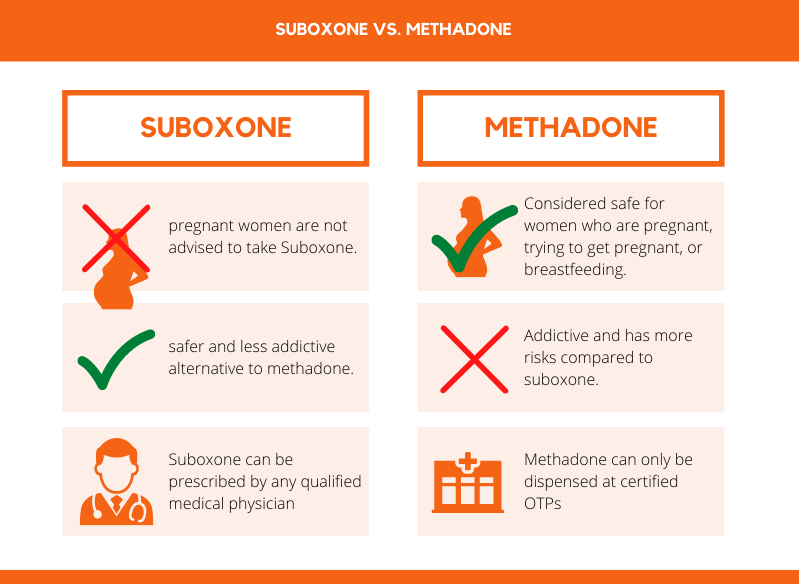Across America, individuals are seeking medical treatment for opioid dependence, but it’s important to understand which medically-assisted treatments (MAT) actually prove to be effective.
In October 2002, the Food and Drug Administration (FDA) approved buprenorphine (Suboxone) as a treatment for opioid dependence. Suboxone, a relatively newer treatment for opioid dependence, has been compared to Methadone a drug developed in the 1960s to reduce/prevent opioid withdrawals and cravings.[1]
The Centers for Disease Control reported that in 2009, 30% of prescription opioid overdose deaths involved methadone, a number more than 4 times higher than that of when methadone first hit the market.[2] Suboxone is often considered a safer alternative to methadone because it has a lower potential for abuse.
While both medications are approved to treat opioid use disorder, there are many differences between Suboxone and Methadone.
How Methadone Works
Methadone is an opioid painkiller. The medication is considered an opioid agonist, meaning it changes how the brain responds to pain signals by binding to and activating opioid receptors. This produces a perceived sense of pain relief.
Methadone is usually taken once a day by mouth in the form of a pill. In addition to being a pain reliever, the medication is used to treat people struggling with opioid addiction. Methadone is a long-acting medication providing relief for longer than other prescription painkillers. It works by reducing withdrawal symptoms and drug cravings without producing a euphoric high as other opioids do.[3]
Addiction treatment centers that prescribe methadone must be certified by SAMHSA as an opioid treatment program (OTP). The medication works best when combined with behavioral therapy, however, there is still a risk for abuse and addiction. Some patients will take methadone just to detox, while others will take it as part of a medication-assisted treatment (MAT) program for a year or more.
When a patient is ready to stop taking this medication, they should consult with their doctor to gradually reduce their daily dose to avoid methadone withdrawal symptoms.
Methadone Side Effects
All medications have the ability to cause side effects. Some minor, more frequent side effects of methadone are:[4]
- Dry mouth
- Drowsiness
- Nausea
- Lightheadedness
- Constipation
- Slowed breathing
Other more serious, yet rare, side effects that require immediate medical attention may include:
- Difficulty breathing
- Rash or hives
- Chest pain
- Swelling of throat, mouth, or face
- Hallucinations
- Confusion
- Irregular heartbeat
- Unstable walking
If used long-term, methadone may lead to a reduced attention span, liver injury, or abuse and addiction.
Methadone Risks and Abuse Potential
As a full opioid agonist, methadone binds directly to opioid receptors. When opioid receptors are activated, it sends signals of pain relief throughout the body. When taken for a long time or abused in large quantities, this produces feelings of euphoria or pleasure. As a result, abusing methadone can lead to opioid dependence and addiction.
Methadone treatment is ideal for people who are not only addicted to opioids but also have the ability to participate in comprehensive treatment and peer support groups. People who have liver problems or those who are not dedicated to attending treatment should not take methadone.
How Suboxone Works
Suboxone, like methadone, is used in MAT programs for the treatment of opioid dependence. This medication comes in the form of a sublingual film containing buprenorphine and naloxone.
Buprenorphine is a partial opioid agonist, meaning it works similar to methadone by binding to opioid receptors. However, naloxone helps reverse the euphoric effects of opioids, blocking a person from getting high.
Suboxone is used to prevent opioid withdrawal symptoms, reduce drug cravings, and block the effects of stronger opioids like heroin or oxycodone. Like methadone, Suboxone should always be used in combination with a substance abuse treatment program.
Since Suboxone is not a full opioid agonist and it contains naloxone, there is a lower potential for abuse and addiction. However, people who stop taking Suboxone may experience withdrawal symptoms. Anyone who is getting ready to stop taking this medication should work with their doctor to come up with a tapering schedule.
Suboxone Side Effects
The most common side effects of Suboxone are:[5]
- Nausea or stomach cramps
- Sweating
- Vomiting
- Headaches
- Constipation
- Sleep disturbances
- Fatigue
Other more serious side effects include:
- Allergic reaction (itching, hives, rash, difficulty breathing)
- Difficulty swallowing
- Unusual bruising
- Flu-like symptoms
- Stomach pain
- Yellowing of the eyes or skin
One of the most common side effects of Suboxone is precipitated withdrawal. This occurs if a person takes Suboxone too soon after taking an opioid and consists of severe opioid withdrawal symptoms.
Suboxone Risks and Abuse Potential
While Suboxone has a lower risk potential for abuse and addiction than methadone, it is still possible for people to become addicted to Suboxone. However, this addiction tends to be physical in nature, meaning people get physically dependent on the substance because their body needs it to function normally. With the help of a dedicated treatment professional, a support group, and a tapering schedule, people can stop taking the medication successfully while avoiding Suboxone withdrawal.
Suboxone is ideal for people who are addicted to opioids and are dedicated to attending a drug and alcohol rehab program as well as a peer support group for the duration of their treatment.
Suboxone vs. Methadone: A Comparison

One major difference between Suboxone and methadone is that pregnant women are not advised to take Suboxone. This is because babies who are born to mothers who are taking Suboxone may be born showing withdrawal symptoms. Methadone, on the other hand, is considered safe for women who are pregnant, trying to get pregnant, or breastfeeding.
The other primary difference between these two medications is the risk of abuse and addiction. As rates of methadone addiction and overdose continued to increase from 2000-2009, addiction professionals found that Suboxone may be a safer and less addictive alternative to methadone.
Lastly, while methadone can only be dispensed at certified OTPs, Suboxone can be prescribed by any qualified medical physician. This makes Suboxone generally more accessible to those struggling with addiction.
Find Help Today
Both methadone and Suboxone are widely used in addiction treatment programs today. The choice between which one a person uses is highly personal and will vary from one person to the next, however, most detoxes and rehabs will recommend Suboxone over methadone due to the potential for abuse.
If you or a loved one are interested in learning more about medication-assisted treatment (MAT) or our Suboxone treatment program in Memphis, pick up the phone and contact us today. Our admissions coordinators are eager to help you get started on your recovery journey.
References:
- https://www.fda.gov/drugs/information-drug-class/information-about-medication-assisted-treatment-mat
- https://www.cdc.gov/vitalsigns/methadoneoverdoses/index.html
- https://www.ncbi.nlm.nih.gov/pmc/articles/PMC1070723/
- https://www.ncbi.nlm.nih.gov/pmc/articles/PMC4001870/
- https://www.ncbi.nlm.nih.gov/pmc/articles/PMC5855417/
Medically Reviewed: September 25, 2019

All of the information on this page has been reviewed and verified by a certified addiction professional.










